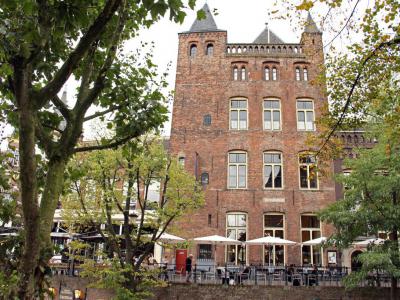Oudaen City Castle, Utrecht
Standing proudly on Oudegracht, Oudaen City Castle is one of Utrecht’s most significant architectural monuments. Originally built in the 1270s, this imposing medieval city castle was once the residence of noble families who sought both grandeur and security along the picturesque Oudegracht. Unlike typical homes of the time, Oudaen was designed with a large main building for prestige and a smaller, more easily heated side structure for comfort.
The castle’s early history is tied to the Zoudenbalch family, one of Utrecht’s most powerful lineages. In 1395, ownership passed to the Oudaen family, whose name remains attached to the property to this day. However, Oudaen was more than just a noble residence-it bore witness to key historical events. During the siege of Vredenburg Castle (1576–1577), it suffered significant damage, and remnants of bullet holes on the rear façade still stand as silent testimony. Later, in 1713, during negotiations for the Treaty of Utrecht, the French envoy Melchior de Polignac was accommodated here.
By 1758, Oudaen had transitioned from a private residence to a retirement home, a role it maintained for over two centuries. A 19th-century renovation saw some changes, including the removal of Gothic arches from the front façade and the replacement of its battlements with a balustrade, though medieval elements remain preserved on its side and rear facades.
After a major restoration in 1986, Oudaen embraced a new identity-one that balances its centuries-old heritage with modern hospitality. Today, it operates as a restaurant, brewery, and event venue, inviting visitors to dine within its historic walls. With locally sourced cuisine and on-site craft beer, it has become a favorite for both locals and tourists. Whether you’re indulging in a meal, savoring a freshly brewed beer, or hosting an event, Oudaen City Castle offers a unique experience where history meets contemporary Dutch gastronomy.
The castle’s early history is tied to the Zoudenbalch family, one of Utrecht’s most powerful lineages. In 1395, ownership passed to the Oudaen family, whose name remains attached to the property to this day. However, Oudaen was more than just a noble residence-it bore witness to key historical events. During the siege of Vredenburg Castle (1576–1577), it suffered significant damage, and remnants of bullet holes on the rear façade still stand as silent testimony. Later, in 1713, during negotiations for the Treaty of Utrecht, the French envoy Melchior de Polignac was accommodated here.
By 1758, Oudaen had transitioned from a private residence to a retirement home, a role it maintained for over two centuries. A 19th-century renovation saw some changes, including the removal of Gothic arches from the front façade and the replacement of its battlements with a balustrade, though medieval elements remain preserved on its side and rear facades.
After a major restoration in 1986, Oudaen embraced a new identity-one that balances its centuries-old heritage with modern hospitality. Today, it operates as a restaurant, brewery, and event venue, inviting visitors to dine within its historic walls. With locally sourced cuisine and on-site craft beer, it has become a favorite for both locals and tourists. Whether you’re indulging in a meal, savoring a freshly brewed beer, or hosting an event, Oudaen City Castle offers a unique experience where history meets contemporary Dutch gastronomy.
Want to visit this sight? Check out these Self-Guided Walking Tours in Utrecht. Alternatively, you can download the mobile app "GPSmyCity: Walks in 1K+ Cities" from Apple App Store or Google Play Store. The app turns your mobile device to a personal tour guide and it works offline, so no data plan is needed when traveling abroad.
Oudaen City Castle on Map
Sight Name: Oudaen City Castle
Sight Location: Utrecht, Netherlands (See walking tours in Utrecht)
Sight Type: Attraction/Landmark
Guide(s) Containing This Sight:
Sight Location: Utrecht, Netherlands (See walking tours in Utrecht)
Sight Type: Attraction/Landmark
Guide(s) Containing This Sight:
Walking Tours in Utrecht, Netherlands
Create Your Own Walk in Utrecht
Creating your own self-guided walk in Utrecht is easy and fun. Choose the city attractions that you want to see and a walk route map will be created just for you. You can even set your hotel as the start point of the walk.
Utrecht's Historical Buildings Walking Tour
Originally founded by the Romans, and once the most important city in the Netherlands, Utrecht boasts a generous share of historically significant structures. The collection of its architectural masterpieces, one of the richest in the country, dates back to the early Middle Ages.
The amazingly well-preserved pieces of historic architecture in Utrecht showcase the trends and movements throughout... view more
Tour Duration: 2 Hour(s)
Travel Distance: 3.8 Km or 2.4 Miles
The amazingly well-preserved pieces of historic architecture in Utrecht showcase the trends and movements throughout... view more
Tour Duration: 2 Hour(s)
Travel Distance: 3.8 Km or 2.4 Miles
Utrecht Introduction Walking Tour
The earliest settlers to the area now called Utrecht likely arrived millennia ago during the Stone Age. While there are also signs of inhabitation during the Bronze Age, scholars today credit the Romans with building what became the town.
They set up a castellum around the year 50 AD, a fort right at a crossing point on the river Rhine. The fortress marked Rome's northernmost point in... view more
Tour Duration: 1 Hour(s)
Travel Distance: 1.6 Km or 1 Miles
They set up a castellum around the year 50 AD, a fort right at a crossing point on the river Rhine. The fortress marked Rome's northernmost point in... view more
Tour Duration: 1 Hour(s)
Travel Distance: 1.6 Km or 1 Miles





